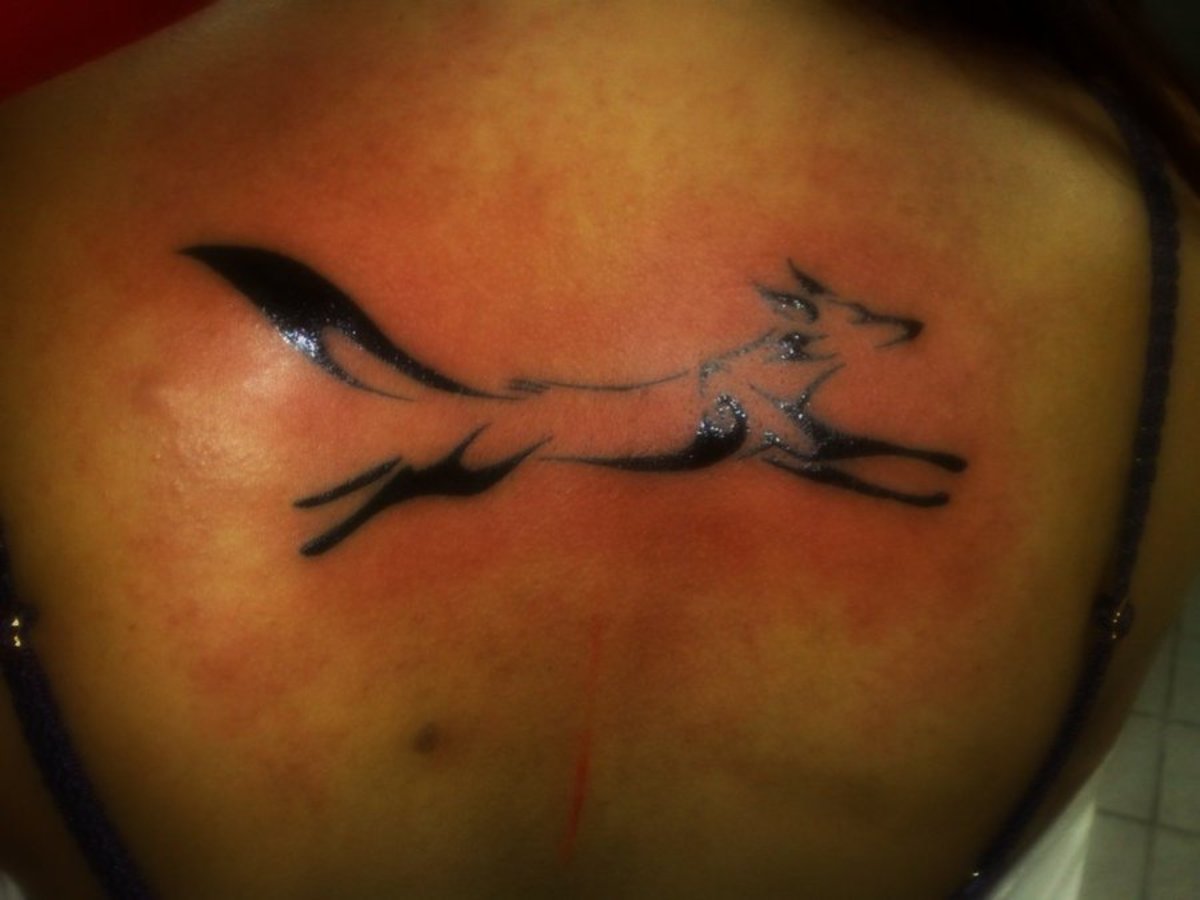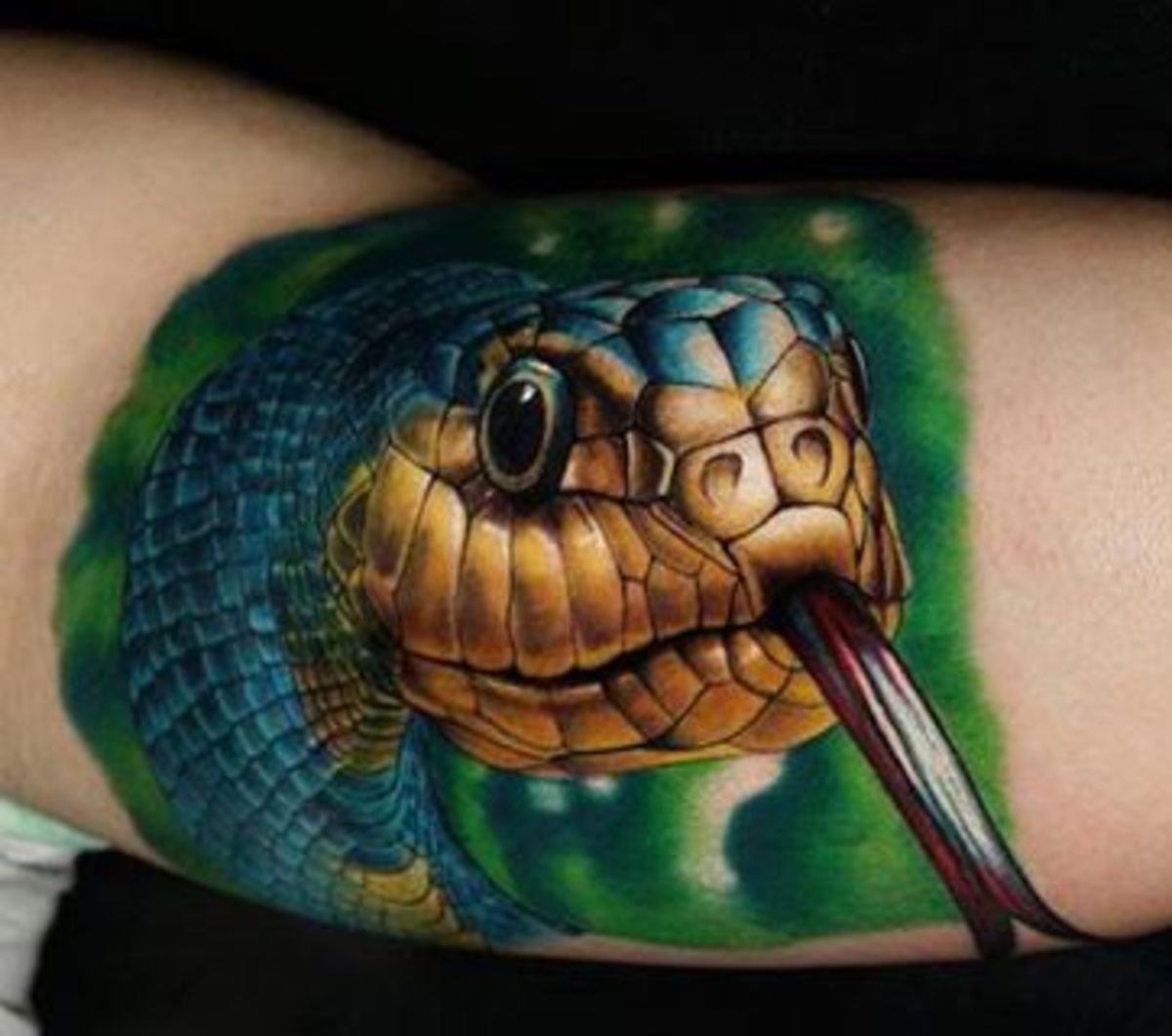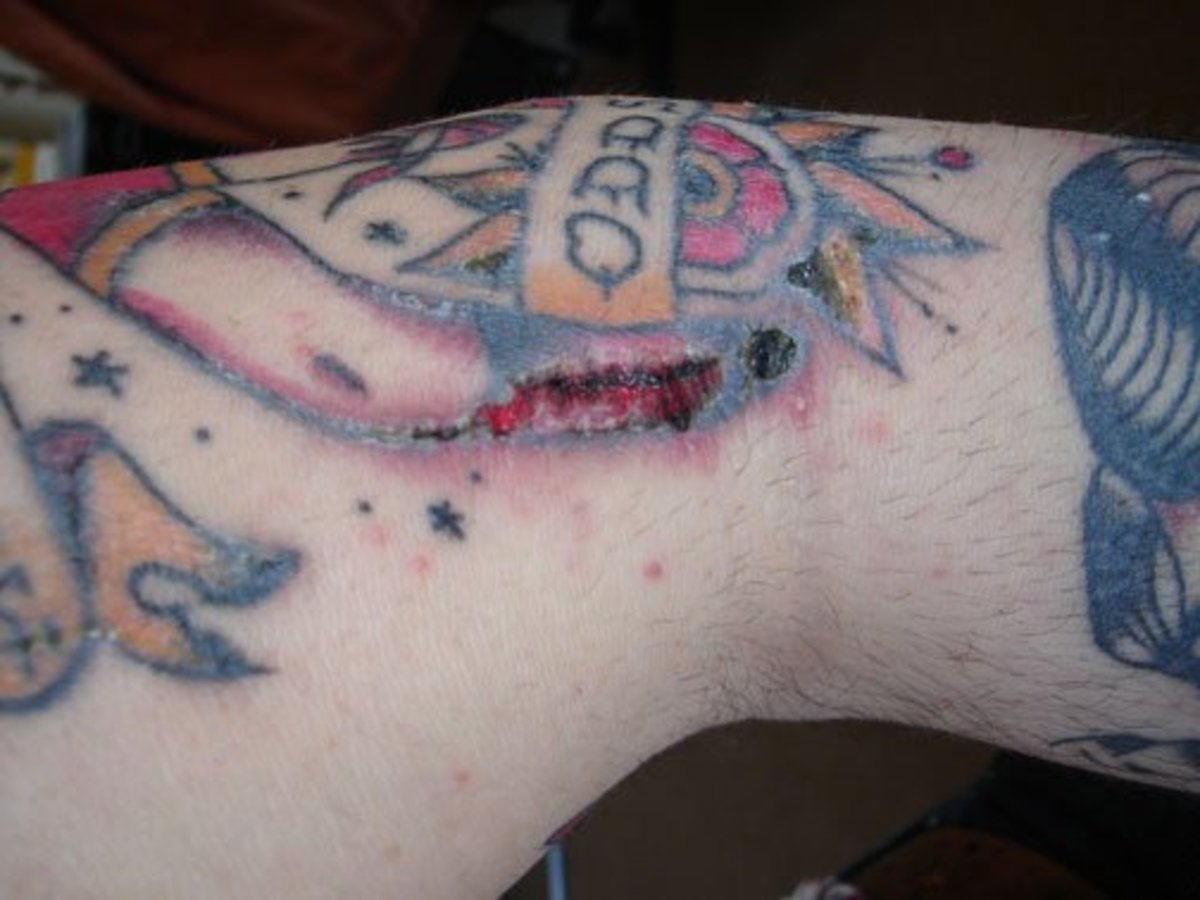
Your beautiful, amazing tattoo is now hurting to buggery, is all red, bruised and swollen. It constantly aches and every time you move it you wince.
Is This Normal?
The short answer is yes. As you got your tattoo, a needle rapidly pierced your skin, passing through several of its layers to deposit ink below the epidermis. The reality is that your body sees your new tattoo as a wound that needs to heal, and part of the healing process is swelling and bruising, medically known as a contusion.
Why Does Your New Tattoo Swell?
Remember
that to your immune system, your fresh tattoo is essentially an injury.
When your body is injured, a blood clot forms around the broken blood
vessels, creating a bruise at the impact site. At the same time, your
immune system sends white blood cells and other natural body chemicals
to the injured area to fight any bacterial or viral anti-bodies that may
try to enter the opening in the skin.
As extra fluids are sent to the injured area, the skin around your tattoo swells which protects and cushions the area from any further injury and helps it heal.
As extra fluids are sent to the injured area, the skin around your tattoo swells which protects and cushions the area from any further injury and helps it heal.

Snake Arm Tattoo | Source
The Most Common Causes of Tattoo Swelling and Bruising
Tattoo Location
- Swelling is more common in the fleshier parts of the body or where there is a lot of blood flow close to the skin. New tattoos are especially prone to swelling if they are under the arm, on the inner area of the leg, on the side of the neck, or on an extremity (e.g. your hands and feet.) That said, any area of the body can experience bruising and swelling.
Blood Thinners
- Blood thinners, such as alcohol, coffee, and aspirin as well as blood-thinning medications should not be consumed before, during, or after receiving a tattoo because they can cause excessive swelling as the tattoo is healing.
The Tattooing Process Itself
- Long sessions and heavy-handed, rough tattooing will naturally result in increased bruising and swelling to the area. To prevent this, you should choose an experienced tattoo artist who will have developed techniques over time to minimise damage to the skin.
Skin-numbing Creams
- Skin-numbing creams restrict blood flow where they are applied. Sometimes, this can result in the nervous system becoming overly sensitive and increasing swelling even further, restricting the body's repairing process.
Skin Sensitivity
- Those who are more susceptible to bruising and swelling for medical reasons or have blood conditions will also experience higher than normal swelling and bruising.
Premium Tattoo Aftercare Kit
Looking
after you new tattoo is extremely important to avoid infection and
excessive swelling. Aftershock Premium Tattoo Aftercare Kit provides all
the lotions that you need to care for your tattoo as it heals.
The package includes:
The package includes:
- Deep cleansing liquid soap.
- Aftercare salve.
- Aftercare lotion.
- Aftercare cream
Stages of Healing for a New Tattoo
- Tattoo bruises and swelling begin as reddish, pink dots that appear in blotches immediately after you leave the tattoo studio. As time passes, the area around the tattoo can start to swell as well and the limb or area may be slightly painful to move.
- Bruising and swelling should go away after one to four weeks, depending on how much the skin was traumatized and the location of your new tattoo.
- As it passes through the various stages of healing, the bruise's colour will evolve into a bluish-purple blob, and then fade to a yellowish green hazy cloud. The multi-coloured wound should then return to its natural flesh tone.
- Your swelling should also reduce at a similar rate as the body passes through its stages of healing and the fluids drain away.
- After three to seven days (or up to two weeks), your tattoo should have begun to peel and will be very itchy. Scabs may form, but it is important to let them fall off on their own and to avoid scratching your tattoo.

Red, sore, infected leg tattoo | Source
Reasons for Swelling and Bruising
- Swelling is more common in the fleshier parts of the body or where blood flow is high and close to the skin. It is reasonably common for new tattoos to swell considerably under the arm, inner area of the leg, sides of the neck, hands and feet, although any area of the body can and will bruise and swell, due to external factors.
- Try to avoid blood thinners before getting a tattoo, as they can cause excessive swelling when healing. Drinking alcohol, coffee and aspirin (also blood thinning medications), should not be consumed before, during or after receiving a tattoo.
- Long sessions and heavy handed, rough tattooing will naturally increase bruising and swelling to the area. An experienced Tattoo Artist develops techniques over time, to minimise damage and tearing the skin, which in turn reduces swelling and bruising.
- Skin numbing creams restricts the flow of blood to the area during use. This can sometimes cause the opposite of the desired result during healing, with the nervous system becoming overly sensitive to the extra blood and fluid flowing into the area thereby swelling even further, restricting the bodies repairing process.
- Those who are more susceptible to bruising and swelling for medical reasons, or have blood condition will also experience more than typical reactions.
Tips to Minimise Bruising and Swelling
1. Apply a cold compress to the swollen area.
This can be as simple as a pack of frozen peas or a cool washcloth. Don't apply frozen compresses or ice directly to the skin. Instead, wrap the cold element in a clean, fluff-free material like cheesecloth or muslin cloth. Leave the compress on the swollen area for about 30 minutes. This will reduce blood flow and limit bleeding into the skin, thus reducing bruising and swelling. It will also alleviate pain and inflammation and speed up the healing process.
2. Elevate the part of the body with the swollen tattoo.
Keep the swollen tattoo above your heart if possible, it may help to lay down. Body areas below the heart, have a higher probability of blood flow into the area, increasing bruising and swelling.
You should attempt to keep the tattoo raised whenever possible for the first 24 hours.
3. Avoid all blood thinners after getting a tattoo, including Aspirin.
If you need to take a painkiller, try ibuprofen and panadol, taking them exactly as the packaging suggests. Consider stopping any blood-thinning medications, but always consult your doctor first.
4. After 48 hours, apply a warm washcloth to increase blood circulation in the area, which will now help your body mend.
You should do this for 10 to 15 minutes, three to four times a day. Alternating between cold and hot compresses can increase your tattoo's healing rate. Ensure you use a hygienic cloth and wash your tattoo after applying the compress to avoid introducing a foreign body, which could result in an infection.
This can be as simple as a pack of frozen peas or a cool washcloth. Don't apply frozen compresses or ice directly to the skin. Instead, wrap the cold element in a clean, fluff-free material like cheesecloth or muslin cloth. Leave the compress on the swollen area for about 30 minutes. This will reduce blood flow and limit bleeding into the skin, thus reducing bruising and swelling. It will also alleviate pain and inflammation and speed up the healing process.
2. Elevate the part of the body with the swollen tattoo.
Keep the swollen tattoo above your heart if possible, it may help to lay down. Body areas below the heart, have a higher probability of blood flow into the area, increasing bruising and swelling.
You should attempt to keep the tattoo raised whenever possible for the first 24 hours.
3. Avoid all blood thinners after getting a tattoo, including Aspirin.
If you need to take a painkiller, try ibuprofen and panadol, taking them exactly as the packaging suggests. Consider stopping any blood-thinning medications, but always consult your doctor first.
4. After 48 hours, apply a warm washcloth to increase blood circulation in the area, which will now help your body mend.
You should do this for 10 to 15 minutes, three to four times a day. Alternating between cold and hot compresses can increase your tattoo's healing rate. Ensure you use a hygienic cloth and wash your tattoo after applying the compress to avoid introducing a foreign body, which could result in an infection.
Diet Tips to Help Your Body Heal

Foods high in Vitamin C. | Source
Diet Tips to Aid the Recovery Process
- Eat more garlic and onion. Besides keeping away people who get too close, some naturalists believe these foods assist healing because of their anti-microbial elements.
- Eat more vitamin C. Vitamin C is commonly found in citrus fruits and sweet vegetables like cauliflower, broccoli, and sweet potatoes. This vitamin is a natural defensive aid in tissue repair and recovery.
- Steer totally clear of alcohol. Not only is it a blood thinner, but it will also cause you to be less protective and careful with your new tattoo.
- Drink plenty of healthy fluids. Water, soups, juices, and herbal teas are particularly good for you.
- Avoid consuming extra dairy products, white flour, sugar, and processed foods. These are known to slow down recovery time periods.
Swelling and bruising
from a new and normally-healing tattoo should be minimal. It will spread
a few centimetres from the edge of the tattoo and will have light
coloured bruising, which will occur over a short period of time.
On the other hand, an infected tattoo has extreme examples of all the above symptoms. The swelling can be so intense that it restricts movement, causes a lot of pain, and spreads a fair distance away from the tattoo itself.
Being hot to the touch is one of the tell-tale signs of an infected tattoo. The tattoo and the area around it is generally very warm, and it may even get to a point when the heat is very uncomfortable and the area needs to be cooled down.
2. Your Tattoo Is Oozing or Has a Tear in It
A second distinct characteristic of an infection is a break or tear in the skin within the new tattoo, where potentially yellow liquid or pus oozes out. Thick dry or wet scabs may be present at the point of infection. Sometimes a bad smell accompanies the oozing. This is definitely a sign of infection.
3. You're Experiencing Fever, Muscle Aches, or General Weakness
These are all signs of a general infection and indicate that you should immediately go to a doctor and seek professional treatment.
Your tattoo is salvageable if it is treated immediately. In most cases, your doctor will prescribe antibiotics or steroids to help cure the infection. If you cannot afford a doctor, seek a medical opinion as a tattoo artist is not a medical expert and will not be able to identify potentially health issues.
It's important that you take care of this as soon as possible because an infection can make the ink leach from your skin, potentially causing your tattoo to appear faded or damaged, which is truly disheartening.
On the other hand, an infected tattoo has extreme examples of all the above symptoms. The swelling can be so intense that it restricts movement, causes a lot of pain, and spreads a fair distance away from the tattoo itself.
Signs of an Infected Tattoo
1. Your Tattoo Is Hot to the TouchBeing hot to the touch is one of the tell-tale signs of an infected tattoo. The tattoo and the area around it is generally very warm, and it may even get to a point when the heat is very uncomfortable and the area needs to be cooled down.
2. Your Tattoo Is Oozing or Has a Tear in It
A second distinct characteristic of an infection is a break or tear in the skin within the new tattoo, where potentially yellow liquid or pus oozes out. Thick dry or wet scabs may be present at the point of infection. Sometimes a bad smell accompanies the oozing. This is definitely a sign of infection.
3. You're Experiencing Fever, Muscle Aches, or General Weakness
These are all signs of a general infection and indicate that you should immediately go to a doctor and seek professional treatment.
What to Do About an Infection
At the first sign of any infection, Go to the Doctor!Your tattoo is salvageable if it is treated immediately. In most cases, your doctor will prescribe antibiotics or steroids to help cure the infection. If you cannot afford a doctor, seek a medical opinion as a tattoo artist is not a medical expert and will not be able to identify potentially health issues.
It's important that you take care of this as soon as possible because an infection can make the ink leach from your skin, potentially causing your tattoo to appear faded or damaged, which is truly disheartening.
What's Happened to Your Tattoo?
Further Reading on New Tattoos
- Is My New Tattoo Infected? What Should I Do about it?
Your new tattoo doesn't feel right and you're concerned you may have an infection. Learn the symptoms of an infected tattoo and find out how to deal with it. - What to Do When Your Tattoo Is Scabbing
Get advice on your tattoo, including information on aftercare, healing, and scab forming. Find out what, why, and how to deal with scabs on your new tattoo. - Tattoo Aftercare Tips, How Should I Look After My New Tattoo?
Practical and tested tattoo aftercare Instructions. Why do you need to do it, and how effective aftercare is done.

Post a Comment